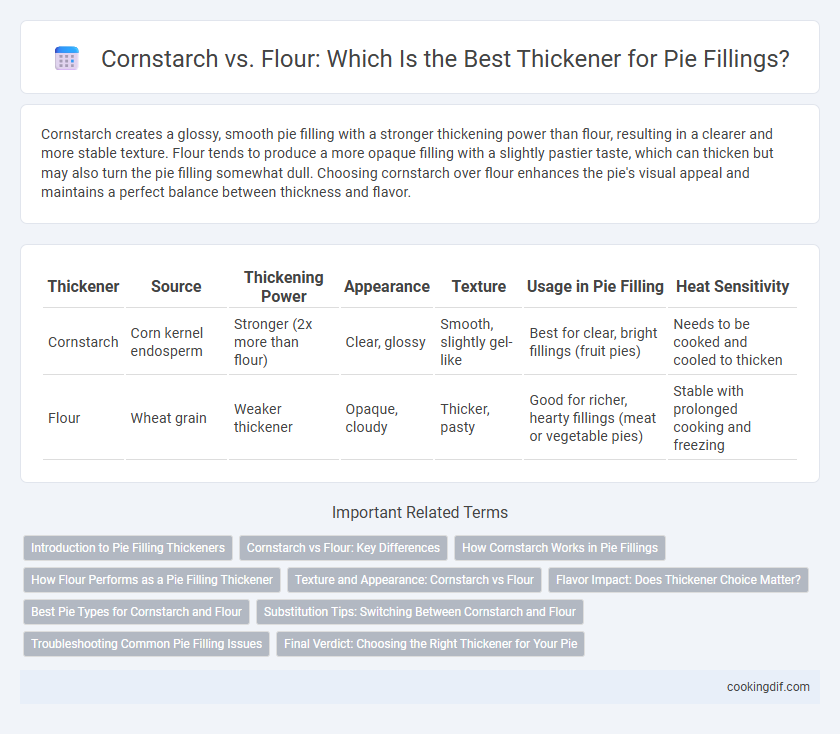Cornstarch creates a glossy, smooth pie filling with a stronger thickening power than flour, resulting in a clearer and more stable texture. Flour tends to produce a more opaque filling with a slightly pastier taste, which can thicken but may also turn the pie filling somewhat dull. Choosing cornstarch over flour enhances the pie's visual appeal and maintains a perfect balance between thickness and flavor.
Table of Comparison
| Thickener | Source | Thickening Power | Appearance | Texture | Usage in Pie Filling | Heat Sensitivity |
|---|---|---|---|---|---|---|
| Cornstarch | Corn kernel endosperm | Stronger (2x more than flour) | Clear, glossy | Smooth, slightly gel-like | Best for clear, bright fillings (fruit pies) | Needs to be cooked and cooled to thicken |
| Flour | Wheat grain | Weaker thickener | Opaque, cloudy | Thicker, pasty | Good for richer, hearty fillings (meat or vegetable pies) | Stable with prolonged cooking and freezing |
Introduction to Pie Filling Thickeners
Cornstarch and flour are common pie filling thickeners, each offering distinct textures and clarity to the filling. Cornstarch creates a glossy, translucent finish with a smooth, jelly-like consistency, ideal for fruit pies such as cherry or blueberry. Flour thickens with a more opaque, matte appearance, resulting in a denser, more pudding-like texture suitable for fillings like apple or pumpkin.
Cornstarch vs Flour: Key Differences
Cornstarch and flour differ significantly as pie filling thickeners due to their thickening power and texture effects; cornstarch provides a clearer, more translucent finish with a smoother texture, while flour creates a more opaque and slightly denser consistency. Cornstarch thickens at lower temperatures and requires careful cooking to avoid a pasty taste, whereas flour needs to be cooked longer to eliminate its raw flavor and achieve full thickening. The choice between cornstarch and flour impacts the final appearance and mouthfeel of pie fillings, with cornstarch preferred for fruit pies and flour more common in cream or custard fillings.
How Cornstarch Works in Pie Fillings
Cornstarch works as an effective pie filling thickener by gelatinizing when heated with liquid, creating a smooth, glossy texture that enhances the pie's consistency without altering its flavor. Unlike flour, cornstarch forms a clearer, more stable gel that prevents the filling from becoming too heavy or pasty. Its ability to thicken at lower temperatures and yield a tender finish makes it ideal for fruit and custard pie fillings.
How Flour Performs as a Pie Filling Thickener
Flour acts as a reliable thickening agent in pie fillings by absorbing liquid and swelling during baking, creating a stable, smooth texture. It requires longer cooking time to eliminate the raw taste and often results in a slightly opaque filling compared to cornstarch. Due to its moderate thickening power, flour is ideal for fruit pies that benefit from a creamier consistency without excessive gel formation.
Texture and Appearance: Cornstarch vs Flour
Cornstarch creates a clear, glossy finish and provides a smooth, silky texture in pie fillings, making fruits like berries or cherries visually appealing and vibrant. Flour, by contrast, produces a more opaque, matte appearance and a thicker, denser texture that can sometimes feel slightly pasty. Choosing cornstarch enhances the visual clarity and lightness of the filling, while flour results in a heartier, more traditional consistency.
Flavor Impact: Does Thickener Choice Matter?
Cornstarch creates a glossy, translucent finish that allows the pie's natural flavors to shine, while flour imparts a slightly cloudier appearance with a subtle, cooked taste that can mellow fruit brightness. Cornstarch's neutral profile maintains the original fruit essence, making it ideal for delicate or tart fillings like cherry or blueberry. Flour's more pronounced texture and flavor might benefit richer or spiced pies, offering a homey, comforting depth to the filling.
Best Pie Types for Cornstarch and Flour
Cornstarch works best for fruit pies like cherry, blueberry, and apple due to its clear, glossy finish and strong thickening power, which prevents filling from becoming watery. Flour suits custard and pumpkin pies where a milder thickener is preferred, providing a softer texture without altering the flavor. For pies that require a translucent filling and quick thickening, cornstarch is ideal, while flour is optimal for pies needing a heartier, more opaque consistency.
Substitution Tips: Switching Between Cornstarch and Flour
When substituting cornstarch for flour in pie filling, use half the amount of cornstarch to achieve the same thickening effect since cornstarch has twice the thickening power. Flour requires longer cooking times to eliminate its raw taste, while cornstarch thickens quickly and creates a clearer, shinier filling. To avoid a cloudy or gummy texture, ensure cornstarch is mixed with cold water before adding to hot pie filling.
Troubleshooting Common Pie Filling Issues
Cornstarch offers a glossy, clear finish and thickens pie fillings more effectively at lower temperatures compared to flour, reducing the risk of a cloudy or dull appearance. Flour can create a slightly thicker, more opaque filling but may result in a pasty texture if overused or undercooked, leaving a floury taste. For troubleshooting common pie filling issues, use cornstarch to prevent weeping and runniness, especially with fruit fillings high in juice, while flour is better suited for cream or custard pies needing a hearty consistency.
Final Verdict: Choosing the Right Thickener for Your Pie
Cornstarch provides a clear, glossy finish and a firmer set, making it ideal for fruit pie fillings that benefit from a visually appealing, gel-like consistency. Flour yields a more opaque, softer filling with a slightly pasty texture, better suited for hearty or custard-based pies. For crisp, vibrant pie fillings, cornstarch is the preferred thickener, while flour suits recipes needing a milder thickening effect and a more rustic appearance.
Cornstarch vs flour for pie filling thickener Infographic

 cookingdif.com
cookingdif.com